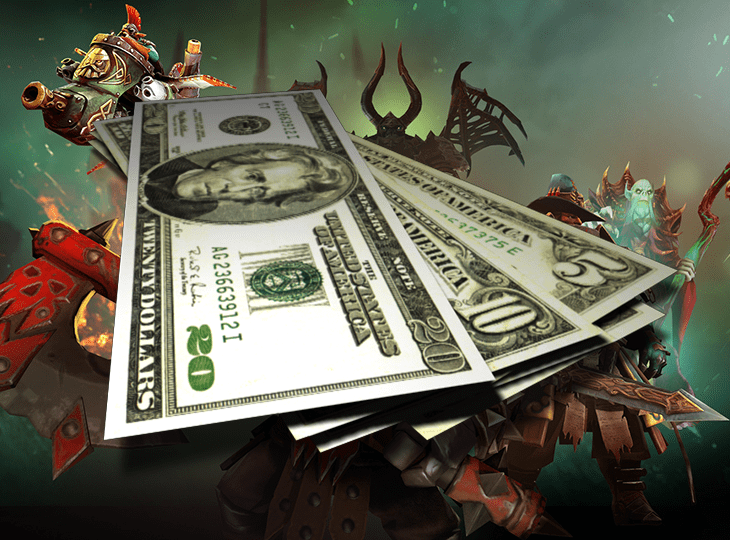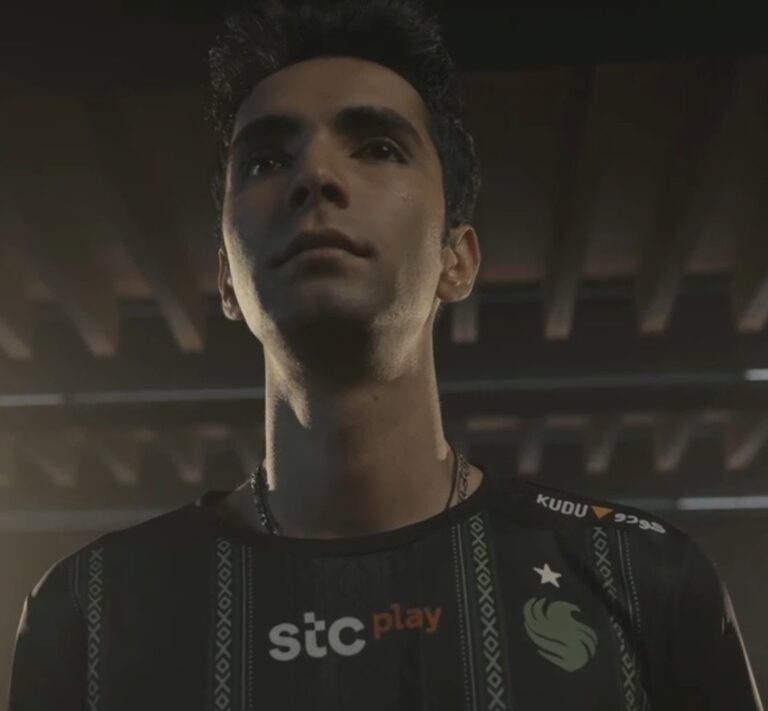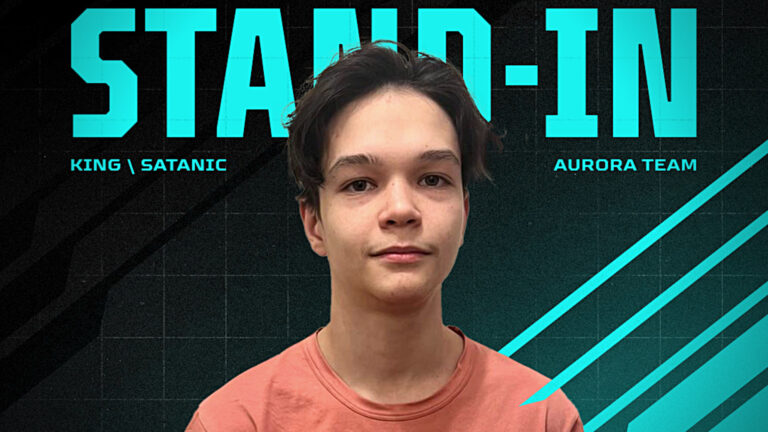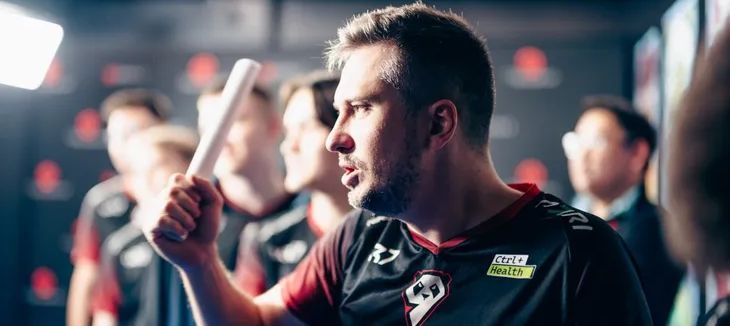Dota pro scene, how much money do pro players make? There was an investigation made by Morf (Russian Dota2 blogger), so here is the transcript and my 2 cents.
Do you know much about how professional Dota players make money?
Sure, you can check Liquipedia and see the total prize money they’ve won, but those numbers don’t reflect reality. They don’t account for the organization’s cut, the coach’s share, and the biggest deduction—taxes.
In fact, for pro players, tournament winnings aren’t even the main source of income. They get paid monthly salaries that most regular workers couldn’t even dream of. Even in the second division, players make at least $10,000 a month. Zai (Team Liquid), for example, was earning around $25,000. It’s an insane amount of money + prize pool money.
So today, I’m going to show you the financial side of Dota. You’ll find out how much players in BetBoom Team, Gaimin Gladiators, Tundra, Team Spirit, Virtus.pro, and other teams are earning. You’ll see what coaches and managers make. And, of course, I’ll show you how much money reaches the winners of multi-million-dollar tournaments.
Get comfortable—this is a full breakdown of who makes what in Dota.
$200 Salaries for Na’Vi and N0tail?
I’m sure most of you are interested in player salaries since there’s very little to no info about them online. So let’s start there.

Back in the early days of competitive Dota, players were making next to nothing. In Na’Vi and Virtus.pro, it was completely normal for even the biggest names of that time to earn just $100–200 per month. And European players weren’t much better off.
“We took the opportunity to go from having no salary at all to having at least something. So we signed our first contract—it was for $200 a month. – N0tail”
Even No-Names Can Make Up to $1000″
When talking about modern Dota salaries, it’s important to clarify one thing—there’s a clear tier system. Just like in basketball, where you have local leagues, the US Championship, and then the NBA, each level comes with vastly different pay.
In Dota, everything starts at the Tier-3 level. Tier-3 players typically earn between $300 and $1,000 per month—not a lot, but enough to get by. In fact, the difference between a professional and an amateur often comes down to whether or not they’re making money from the game.
But don’t get the wrong idea—not every player is cashing in big.
Getting a Salary in Dota Pro Scene Isn’t Easy
Even with a high MMR, landing a salaried spot on a team is incredibly difficult. Right now, there are only 14 organizations in the CIS region, and less than half of them even have Tier-3 rosters.
So what’s the point of grinding thousands of hours just to hope that a team like Nemiga picks you up for $300 a month?
Poor Ramzes
When talking about Dota salaries, it’s worth mentioning that most of today’s stars started at Tier 3. For example, Ramzes’ first salary in the SFZ team was just $250 a month.
Or take HellRaisers, who signed the Tier-3 player Afoninje back in 2014:
“When I joined HellRaisers, I think I was making around $400 or $500. – Afoninje“
So if you’re just starting your journey as a pro Dota player, don’t expect to get rich anytime soon.
Tier-2 Salaries: Na’Vi, Virtus.pro, 9Pandas
After Tier-3, you move up to Tier-2, where teams like Na’Vi, Virtus.pro, and 9Pandas compete. The key difference? These teams consistently place well in smaller tournaments and are constantly fighting for qualifications for top-tier events.
Tier-2 players earn more, but they’re still far from making millions. Their salaries typically range from $2,000 to $2,500 a month. Some pros estimate Tier-2 salaries anywhere between $1,000–$3,000 per month, depending on the organization.
For example, compare legendary Na’Vi to a new team like Chimera, which recently entered the scene. Who do you think has an easier time attracting sponsors and increasing salaries? Obviously, the more established team. Yet, these players all compete at the same Tier-2 level.
However, don’t assume that just because an organization once had a big name and it has the same money right now.
A Big Org Doesn’t Always Mean Big Money
Just because an organization has a big name doesn’t mean it has to pay top salaries. Let’s take Team Empire as an example. Back in 2014-2015, they were a strong team, winning tournament after tournament. Even after that, they remained a well-known name.

But when Ramzes joined them in 2016, he was only getting a Tier-2 salary. “At Empire, I was making about $1,500 a month. – Ramzes”
Or look at Virtus.pro with their legendary roster. At their peak, they were obviously earning Tier-1 salaries (you’ll see the exact numbers later in this article). But by 2023, VP was only competing in Tier-2 events—and not even winning them.
The same goes for BB Team’s original roster—they mostly played Tier-2 and Tier-3 tournaments, though at least they managed to secure wins. Their salaries reflected that.
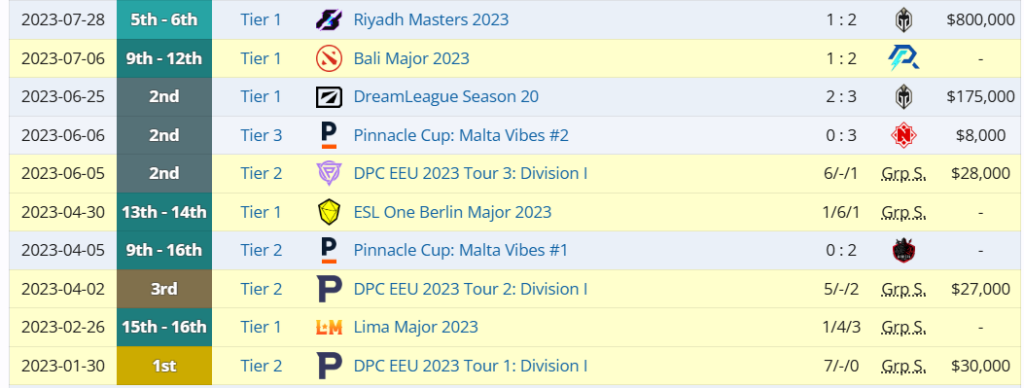
For example, before Daxak and SoNNeiKo joined BetBoom, both BB Team and Virtus.pro were paying players around $2,000 a month. Could they have paid more? Sure—but why would they? If you’re not competing at the highest level, your salary reflects that.
Of course, there are exceptions. Take Loda, for example. He was paying his players insane salaries for Tier-2 competition—up to $10,000 a month.
I know this from Limitless, who stood in for Alliance back then. Keep in mind—$10,000 per month is Tier-1 salary territory, and not even for the weakest teams at that level.
Another team notorious for overpaying without results? Entity. Performance-wise, they were a classic Tier-2 team—winning small events and constantly failing to qualify for Tier-1 tournaments.

And yet… look how much they were making:
“So, you’re making about $5,000 per month – Interviewer?”
“DM – Yeah, probably closer to $10,000.”
Then there were teams like Nouns—players like Fly and co., grinding in the dead zone of North American Dota, constantly losing to Shopify Rebellion and failing to qualify for big events.
So, how much do you think they were making? Their salaries were around $7,000–8,000 a month.
My point is: even at the Tier-2 level, salaries vary wildly and don’t always match results. And when it comes to the elite level… well, that’s a whole different story.
Salaries by Region
If we generalize the Tier-1 scene, top-level players typically earn between $3,000 and $20,000 a month. But there aren’t that many teams in the world paying those kinds of salaries.
In reality, exact earnings depend on many factors. For example:
- Southeast Asia (SEA) and South America have lower salaries compared to other regions.
- China and Europe have traditionally been the most generous—their organizations have always been willing to pay more.
- However, in the past few years, Chinese Dota has collapsed, and even top players there struggle to find sponsors.
What Determines a Top Player’s Salary?
At the Tier-1 level, salaries depend on more than just skill:
- Media presence (how marketable the player is)
- Recent tournament results
- The structure of the contract (fixed salary, bonuses, performance-based increases, etc.)
At Tier 1, everything is highly individual—there’s no single standard. But let’s break it down, because I’m sure an abstract range of $3K–$20K isn’t enough for you.
How Much Do Players Make in the CIS?
For the CIS region, we actually have solid data, thanks to Dyrachyo’s interview.
According to him, the best players in CIS earn between $10,000 and $15,000 per month. Here are some examples:
Virtus.pro’s “Golden Roster”
“We were making up to $10,000, sometimes more in certain periods, but our average salary was around that mark. – Rodjer”
Toward the end of their dominance, they were earning even more—some players were getting $20,000 a month. But when the roster first formed, they were only offered a base salary of $3,000.
Virtus.pro’s Golden Roster Salaries
The Virtus.pro golden roster had salaries of up to $10,000 per month, sometimes even more in certain periods. On average, their salaries hovered around that mark. However, toward the end of the roster’s era, their pay increased—according to my sources, some players were earning $20,000 per month. (Maybe Solo and Ramzes?)
At the very beginning of their journey, though, their base salary was much lower—for example, my first Virtus.pro contract was for $3,000 a month.
Salaries in BB Team, Spirit, and Parivision
About six months ago, Sergey Glamazda (ex VP manager) mentioned that a top-4 team in the world was paying salaries between $12,000 and $15,000 per month.
Now, let’s look at the top-4 teams at that time. Actually, let’s expand it to top-6:

- Falcons, Gaimin Gladiators, Tundra, and Team Liquid
- I know for a fact that these teams were paying even more than that (we’ll get into specifics later).
So, which team was Sergey referring to?
- Could it have been China’s Xtreme Gaming?
- Or was it Russia’s BB Team?
One thing to consider—Glamazda works in the betting industry, and BB Team is owned by a competing bookmaker. That means he likely knows what salaries his competitors are offering, and he was referring specifically to them.
CIS Top Teams: ~$15,000 Per Month
Right now, top CIS players make around ~$15,000 per month.
From what I’ve heard, in BB Team, Parivision, and Team Spirit, salaries are around this same level. There are rumors that some individual players may be earning up to $20,000 per month, but this isn’t confirmed.
European Teams Earn Even More
If CIS salaries look high, Europe is even crazier.
Again, thanks to Dyrachyo’s interview, we know that top European players earn anywhere from $15,000 to $30,000 per month.
Specific examples:
- Team Liquid and Falcons pay over $20,000
- Their players benefit from bonus structures, which significantly boost salaries
- When Tundra won TI with 33, their players immediately got salary raises
Gaimin Gladiators: The Kings of Salaries
At Gaimin Gladiators, players are rumored to be earning $30,000 per month.
And I’m almost certain that their new roster (with Watson, who hasn’t performed well yet at least in DreamLeague Season 25) is still on those same contracts.
So yeah, some of these guys secured insane salaries—whether they keep justifying them is another question.
Questions About Avulus
Here are the top 10 teams in the ESL rankings right now and their salaries.
| Team | Salary/Month |
|---|---|
| $12000–$15000 | |
| $12000–$15000 | |
| $20K | |
| $20000–$25000 | |
| $12000–$15000 | |
| $15000–$20000 | |
| $5000–$7000 ? | |
| $5000–$8000 | |
| $15000+ | |
| $5000–$7000 |
I put a question mark next to AVULUS because they originally started as a tier-2 team with no major achievements. That means their salary situation could vary: they could have signed a fixed contract for $2,000–$3,000 a month, or they might have negotiated bonuses for qualifying for top tournaments. It’s also possible they renegotiated their salaries to $5,000–$10,000 a month after breaking into the top 10 teams in the world.
The situation with Nigma is unclear as well. They’re backed by Arab sheiks, so you’d expect them to be paid well, but the team hasn’t had good results for a while now. There’s also Quest, another team backed by the Middle East, but they pay way below what’s expected for the region.
Despite these uncertainties, the general salary range is clear:
- European teams are the highest paying.
- Top CIS teams typically pay around $15,000–$20,000 a month.
Prize Money and How It’s Actually Distributed
When talking about Dota players’ earnings, you can’t ignore prize money. However, as I mentioned earlier, the numbers on Liquipedia don’t reflect the real picture.


For example, Satanic’s total prize earnings are listed as $78,500 on Liquipedia.

But if you actually check the tournaments where he earned money, it adds up to $396,132.
So why the difference? Liquipedia simply divides the total prize pool by five players, assuming they share equally. But in reality, players get much less because:
- The organization takes a cut – usually 15–25%, with the average being about 20%.
- The coach also takes a percentage, generally around 5% or more.
- In some teams, analysts and managers also take a cut, though this is less common.
In the CIS region, this means players end up with just 15% of the prize money.
For European teams, it’s pretty much the same, as confirmed by Dyrachyo.
And that’s still not the whole story…
Taxes Take Up to 60% of Prize Money.
It’s one thing to hold a check that says “one million dollars” and another to actually receive the money. Surprise, surprise – prize money is considered income, and because of this, you have to pay taxes. You pay tax in the country where the tournament took place, and this is usually between 20% and 40%. Just think about it: in most cases, 30% is taken right off the top.
Then, you have to pay an income tax in your home country. For example:
- Russia takes 13%
- Ukraine takes 19.5%
- Sweden takes around 30%
- Finland even takes 57%! (That’s robbery right here)
So players like Rex who won The International end up with far less money than they expected. Here’s confirmation of this from an Alliance manager: Sweden takes half of their prize money. Here’s also information from Topson’s stream: 60% of his prize money from The International was taken in taxes.
Let’s Calculate Specifically for Topson
Now, let’s break it down for Topson. OG won over $15 million for their victory at The International 9. Let’s calculate based on his 15% share of the prize pool:


- From the $15 million, his cut is $2.25 million.
- Now, we deduct the 20% tax from the tournament’s location (China), which equals $450,000.
- Then, we subtract 57% from Finnish taxes, which is another $1.28 million.
So, out of the $15.5 million OG won, Topson only ended up with around $800,000. This is a far cry from what Liquipedia reported, which was over $3 million – the actual number is off by four times. Instead of receiving 20% of the prize, Topson only got about 5%.
A Comparison of Russia
Now, let’s do the same calculation for Russia, where players typically keep about 90% of their prize money after taxes.
For example, Durachyo earned about $200,000 in prize money last year. If we sum it up with his salary of $25,000 a month, he earned an additional $300,000. He would pay tax on that, of course, but only once in his home country.
So, adding his prize money and salary, Durachyo took home around $460,000 per year, or about $40,000 a month.
Interesting Fact: Progressive Tax in Russia
A fun fact: this year, Russia introduced a progressive tax system – the more you earn, the higher your tax rate. So, Durachyo will have to pay 20% or even 22% tax instead of just 13% in the future.
Save Earnings for the Year
In the past year, Save earned almost 2 million rubles in prize money with BetBoom Team. After taxes, he was left with 176,000 rubles, and with a salary of 12,000 rubles a month, he earned an additional 144,000 rubles. So, in total, over the year, Seif took home 30 million rubles, which is about 2.5 million rubles per month.
Solo’s Situation
For Solo, it’s not as smooth sailing. He earned very little in prize money, with only about $1,200 for the whole year. So, he lives exclusively on his salary of $2000 a month.

However, some media personalities like Solo, Durachyo, or Ramzes have individual advertising contracts. You understand that being an ambassador for a bookmaker or promoting products can bring in tens of thousands of dollars.
Personal Advertising Contracts
When it comes to personal advertising contracts for Dota 2 players, I don’t have specific numbers. These are generally rare cases for top media personalities, so they aren’t always relevant. The top players, even without these contracts, earn quite well. When you add their salaries and prize money together, they’re pretty much oligarchs. However, if these numbers suddenly motivate you to become a pro Dota player, listen closely.
The Harsh Reality
In the CIS, there are about 20 professional teams in Dota with decent salaries and prize money. If you also count CIS players playing in other regions, there are about 120 CIS players who have earned something in the past month, either professionally or semi-professionally.
Think about it: only 100 CIS Dota players earn anything. Out of them, really good earnings are limited to about 20 or 30 players. And how many people are actually playing Dota worldwide? Even to make it to a Tier 3 level, you have to be an absolute grind machine.
Take Satanic, for example. He spent years grinding in Dota, with no income, and only when he was 15 did he get signed by Team Spirit. And even then, he was lucky that Korb3n, the manager, saw his talent.
Huge Coach Salary
Greg, wait a minute, you can still get a job in a top team in another way. Yes, indeed, for example, by becoming a coach. According to the current coach Achilles, in this position, you will earn the same salary as the players, plus a share of the prize money. Of course, it’s only 5% and not 15%, but with the salary, it’s still very good money. The same applies to Boolk (BetBoom Coach) or Silent (Team Spirit Coach). Boolk, for example, earns about $15,000 per month.
Prize Money for BetBoom Team

Now, going back to BB Team’s prize money for the year, if we take 5% of that and subtract all fees, you’ll still be left with about $70,000, which is more than $5.681 per month, and that’s without including the salary. Even if Boolk earns only half of a player’s salary (which I personally doubt), he still makes over $10,000 per month.
In top teams, there are often assistant coaches or analysts. However, such people earn significantly less, and as a rule, they don’t get any percentage of the prize money.
Manager’s Salary
And of course, let’s not forget about managers. The huge advantage here is that you don’t need gaming skills – just a basic understanding of Dota is enough. The real question is: how much do they get for babysitting the players?
Let’s take a look at an article by a guy named KSU, who worked at NaVi for four years in various positions. At first, he exaggerates a bit about not knowing players’ salaries, but that’s not so important for us. What matters is the info he shared from 2015, which is much more valuable. KSU indicated the salary levels of managers compared to players. If you divide a player’s salary by the manager’s salary, it’s a ratio of 2.5. In other words, the manager gets 2.5 times less than the player.
- Tier 3 manager: $100 to $400
- Tier 2 manager: $500 to $1,000
- At the highest level, a manager’s salary is from $1,000 to about $5,000 per month. This is true for people like Lukawa (BetBoom manager) and Korb3n, and tier-1 teams always have their own specifics.
Team-Specific Differences
First, a team might have several managers, as in the case of BetBoom Team, so the salary for any particular person would be lower. Second, if the person is the one assembling the roster, like Korb3n or Zai, their salary is often supplemented by a percentage of the prize money.
Realities of the Job Market
Again, all of this sounds great in theory, but in practice, vacancies for a coach or manager of this level only come up about once a year across the entire pro scene.
Plus, you understand that these positions aren’t typically open to just anyone. Without a history in Dota or connections, your chance to become the next Korb3n or Bulk is practically zero.
In short, if you were thinking of tying your life to a professional Dota team, think again. The chances of making it are slim, and the reality might be that you end up washed up, stuck with no career, and living off your parents at an old age.
Fun Fact: JerAx’s Tax Optimization Scheme
For most of his income, JerAx declared not under his own name, but through his Finnish company, similar to a US LLC(Limited Liability Company).
